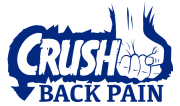The Top 3 Exercises For Sciatica
What’s causing the sciatica?
The cause of sciatica dictates the exercise selection. If the cause of sciatica is not determined then exercise selection is a guess, and may or may not be effective.
Fortunately it’s not especially difficult to determine if the sciatica pain is related to an issue at the lumbar level, or something going on with the piriformis muscle.
Sciatica symptoms either come from the nerve being irritated at the lower back or at the piriformis muscle.
If the nerve is irritated at the lower back a herniated or bulging disc is often the cause.
When sciatica symptoms are related to disc herniations or bulges, you will most likely have a directional preference.
It’s especially important to determine if you have a directional preference because when you do the sciatica symptoms are related to the lower back.
Determining if you have a directional preference tells you where the symptoms are coming from AND what direction of movement will reduce the symptoms
A directional preference is exactly what it sounds like. Moving your spine in one direction will result in sciatica relief while moving your spine in the opposite direction will increase your symptoms.
Your directional preference is the direction of movement that reduces your symptoms
The majority of people with sciatica have a directional preference into extension. Extension of the lumbar spine is bending the spine backward.
Repeated extension has been shown to reverse disc prolapse.
This video shows you how to determine if you have a directional preference and the most important exercise to do if your directional preference is extension.
Prone press-ups are the top exercise to do if you have a directional preference into extension
Determining if there is a directional preference tells you what exercises to do
Once a directional preference or lack thereof is established, specific exercise and movement work that facilitates the healing process can be commenced.
The Herniated Disc With Sciatica Program is a step by step program designed for those with a directional preference into extension.
What if there is not a clear directional preference?
If you are unable to determine a clear directional preference then it’s possible your sciatica pain is related to dysfunction of the piriformis muscle.
Piriformis Syndrome
Piriformis syndrome is a type of non-discogenic sciatica.
Most of the time sciatica is caused by a bulging disc or a herniated disc. In the case of piriformis syndrome the sciatica symptoms are not related to the disc. They are due to dysfunction of the piriformis muscle.
If sciatica pain is due to piriformis syndrome, dysfunction of the piriformis and pelvic girdle musculature must be addressed.
The first step is to determine if you even have piriformis syndrome.
Piriformis Syndrome Tests
- Piriformis stretch test
- FAIR test
- Piriformis contraction test
For any of of these test to be considered positive familiar sciatica pain must be provoked.
This video covers the tests to determine if sciatica is related to dysfunction of the piriformis muscle.
The Top Two Exercises for Sciatica Caused by Piriformis Syndrome…Strengthening The Gluteus Medius and Maximus
The two piriformis syndrome exercises outlined in the next video address common muscle weaknesses often present with piriformis syndrome.
These are not stretches. It’s common to stretch the piriformis muscle when piriformis syndrome is suspected.
Stretching may feel good during though usually does not result in long-term pain relief or a resolution of symptoms.
One theory of what causes piriformis syndrome is a tight, spasmed piriformis muscle. Hence the stretching approach.
Another theory is that the piriformis muscle is having to function in a lengthened position with high eccentric loads during functional activities. This in turn irritates and/or compresses the sciatic nerve.
It’s well documented in the research literature on piriformis syndrome that gluteus maximus and gluteus medius muscle weakness is common.
If these muscles are weak the piriformis muscle has to pick up the slack, the result being possible irritation of the sciatic nerve.
Research has shown that strengthening the gluteus maximus and gluteus medius muscles reduces piriformis syndrome symptoms.
The bridge and clam shell exercises are outlined
Do two sets of 10-15 reps, two times per day. Stick with these exercises for two weeks.
If you start to have less sciatica pain doing these exercises check out the next video that progresses the piriformis syndrome exercises.
Exercise Progressions
The exercises outlined in this video force you to use the gluteus medius and gluteus maximus in an upright, weight bearing position.
If the exercises in part I reduced your symptoms after two weeks progress to these two exercises for the next two weeks.
The squat and single leg mini-squat are covered
Do two sets x 10-15 reps of the squat movement and two sets of 6-12 reps of the single leg work. Do this two times per day.
After two weeks of completing these drills check out Part III of this piriformis syndrome exercise series.
Part III builds on the first four weeks and will further shore up weaknesses while reducing sciatic pain from piriformis syndrome.
Part III
This video continues with a focus on optimizing the strength and endurance of the gluteus medius and gluteus maximus.
The glut med sequence and the rear foot elevated split squat are outlined.
For the glut med sequence start with 8-10 reps of each of the four movements. Do the movements in sequence, without stopping. Work up to 15-20 reps of each movement over the next two weeks.
For the rear foot elevated split squat you’re going to use bodyweight and start with around 15 reps. Work up to 20-25 reps over the next two weeks.
If piriformis syndrome symptoms and sciatic pain are related to glut med dysfunction, the exercises outlined in this video series will eliminate or at the very least greatly reduce your symptoms.
FAQs
If sciatica symptoms are caused by a herniated or bulging disc you need to determine if you have a directional preference. Then focus on exercises that move the lower back into the directional preference. If sciatica symptoms are related to dysfunction of the piriformis muscle focus on exercises that strengthen the gluteus maximus and gluteus medius musculature.
Exercises that reduce leg pain. The direction of spinal movement that reduces leg pain is referred to as the directional preference. When a directional preference is present, exercises should focus on moving the spine into the directional preference. Extension is the most common directional preference for people with sciatica related to a disc herniation or bulge. If sciatica is not due to a disc issue then it may be related to piriformis syndrome. When this is the case exercises that strengthen the gluteus maximus and medius muscles are effective at reducing sciatica pain.
Focus on directional preference based exercises if a directional preference is present. The directional preference is the direction of spinal movement that reduces or alleviates leg pain. For the majority of people with sciatica extension is the directional preference. If there is no directional preference then focus on strengthening the gluteus maximus and gluteus medius to decrease stress and strain on the piriformis muscle. Less stress/strain through the piriformis muscle results in less tension and irritation on the sciatic nerve.
Exercises that centralize the leg pain. Centralizing the pain simply means to reduce or eliminate the pain in the leg. If there is sciatic pain felt down into the mid calf then centralizing the pain would mean the calf pain decreased or went away. Basically the pain decreases in the periphery (leg) and comes up closer to the lower back. The direction of spinal movement that results in centralization of leg pain if called the directional preference. The majority of people with sciatica pain have a directional preference into extension. When this is the case exercises that facilitate spinal extension must be the focus. Less common is a directional preference into lumbar flexion. If flexion is the directional preference then exercises must focus on lumbar flexion. If there is no directional preference then exercises that strengthen the gluteal and core musculature should be the focus.
REFERENCES
Scannell JP, McGill SM. Disc prolapse: evidence of reversal with repeated extension. Spine (Phila Pa 1976). 2009 Feb 15;34(4):344-50. doi: 10.1097/BRS.0b013e31819712a6. PMID: 19214092.



